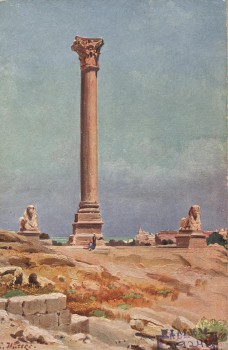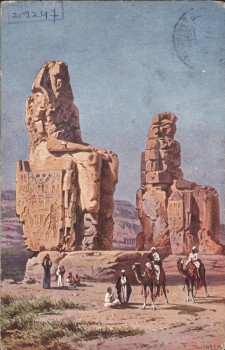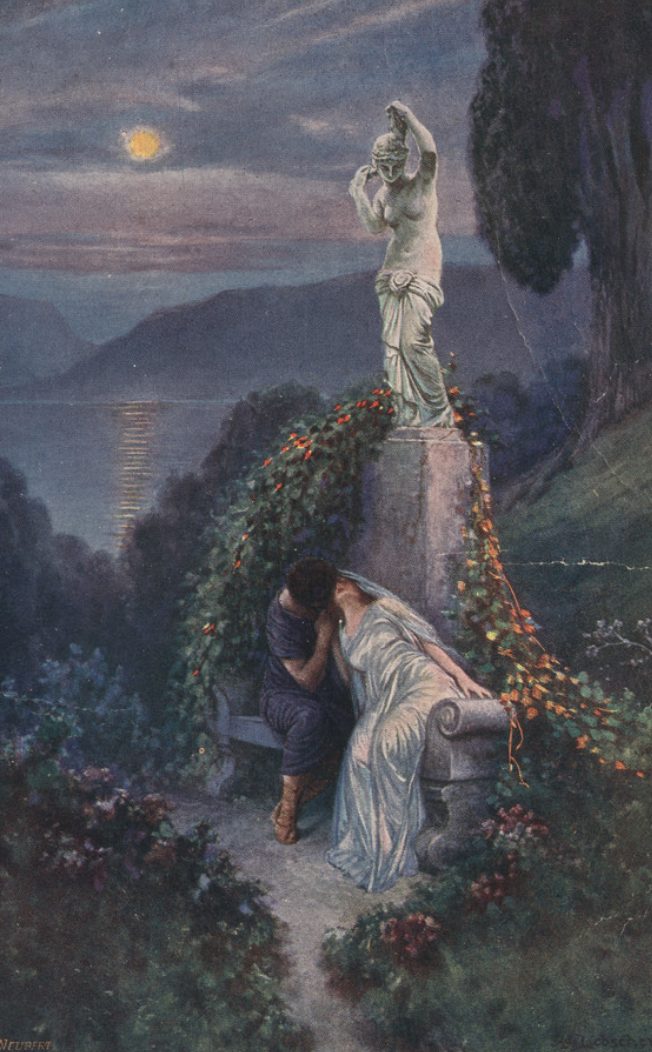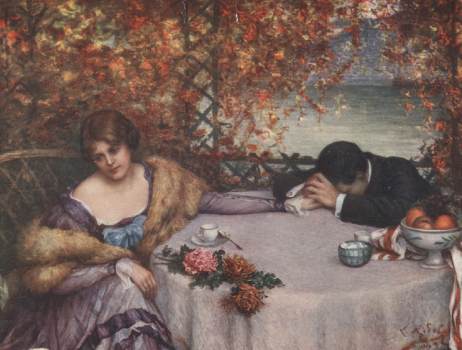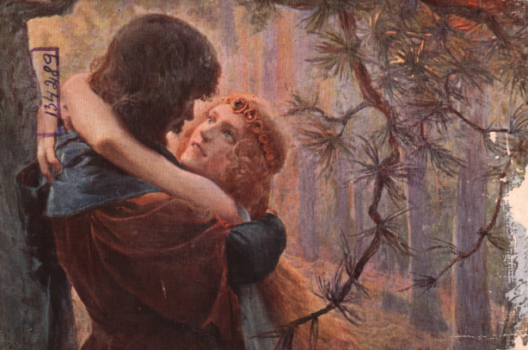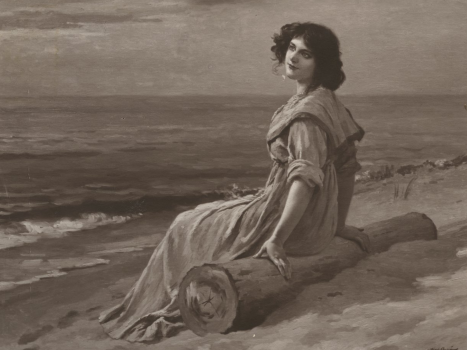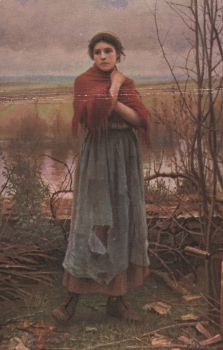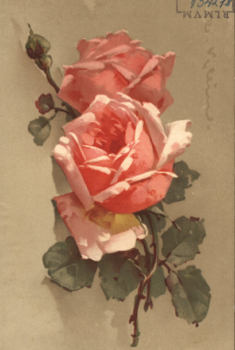Aspazija’s postcards
The correspondence between Rainis and Aspazija is registered in the UNESCO "World Memory" list in the Latvian National Register. There are nearly 2,500 letters in Latvian, Russian and German, and a substantial proportion of the letters were written on postcards.
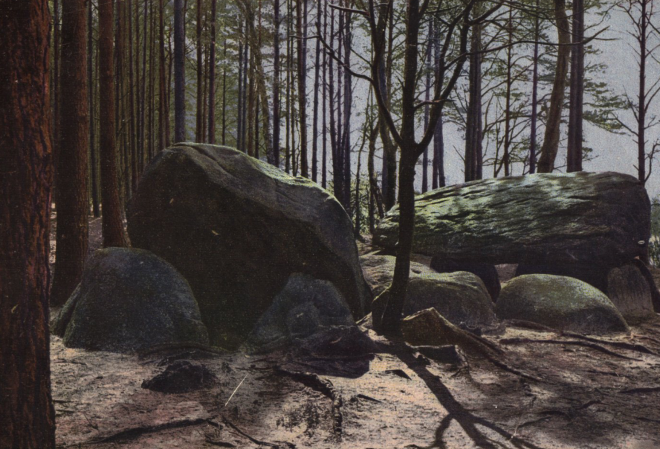
Rainis wrote his first letter to Aspazija on February 4, 1894, asking for permission to publish one of her poems in the newspaper “Daily Page” (Dienas lapa). Rainis’ last letter to Aspazija was a postcard from Cairo, and he sent it to Baznīcas Street in Rīga during the early days of May 1929. Rainis concluded his text with the words “Fly, fly!”
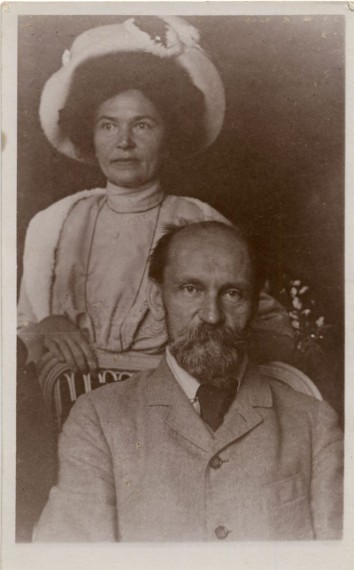
Rainis and Aspazija in Zurich, 1912. Unknown photographer
They were particular fans of illustrated postcards when they were in exile in Switzerland. When Rainis was deported or one of the poets was gone, they corresponded every day and sometimes more than once per day. Scenes of nature and cities, antique motifs and images of distinguished individuals were on the front of the postcards, but on the other side the poets would send short information about their lives ˗ their daily plans and work, the latest news and greetings from their friends.

Reproduction of Friedrich Perlberg's "Sand Storm Near the Great Sphynx"
Aspazija’s collection of postcards speaks to the trends of postcards in the early 20th century and the poet’s interests. Several postcards are illustrated with flowing images of roses and other flowers. This was part of the aesthetics of neo-Romanticism. In the early 20th century, Aspazija was once again interested in ancient culture and particularly Ancient Egypt. This is seen in more than 10 postcards with images of Ancient Egypt, Greece and Mesopotamia.
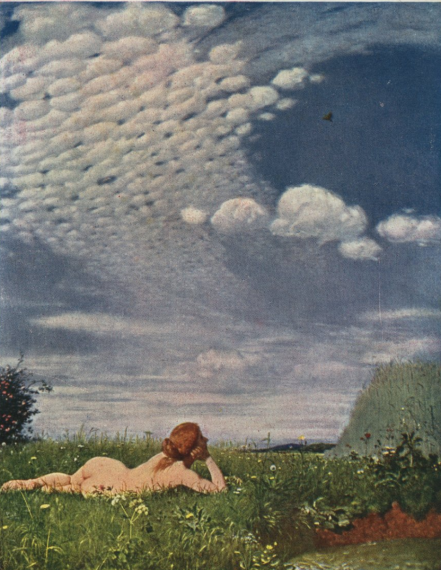
Reproduction of Pal Szinyei Merse's "Lark"
Aspazija did not use postcards just for correspondence. She sometimes put them into albums. Aspazija had several such albums, and the postcards were arranged by theme ˗ postcards with comparable motifs or reproductions of the art of a single artist in one album.
Check out Aspazija’s postcards!
Bacchanalias
Reproduction of Anselm Feuerbach's " Silenus with Young Bacchus"
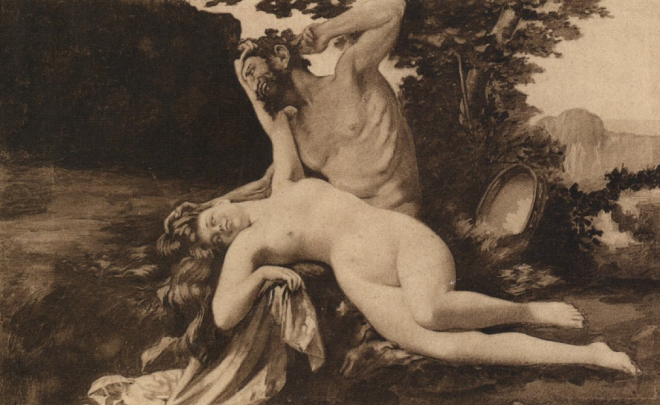
Reproduction of Henri Gervex's "Satyr Playing with Bacchante"
One of the topics for Aspazija’s poetry and postcard collection was bacchanalias. In Ancient Rome and Greece, that was a festival devoted to the god of fertility and wine, Bacchus (Dionysus in Greece). The festival involved theatrical performances, dancing, singing and lots and lots of wine. Bacchanalias symbolised nature and the reality of irrational impulses. In some of her poems, Aspazija wrote about the temptations of hedonistic parties, because everything, after all, is ephemeral and fading. During the petty lives, joy is the only true treasure.
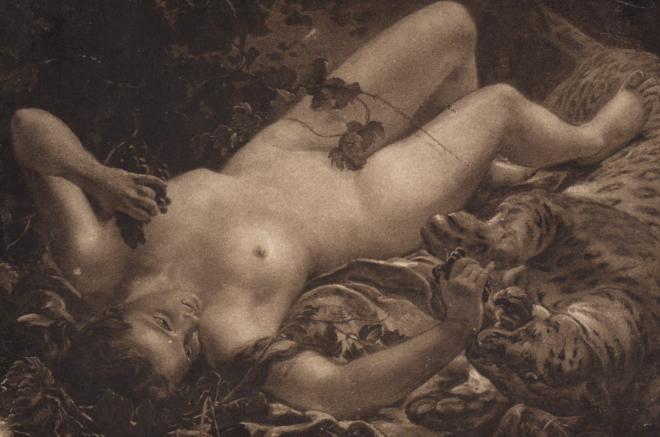
Reproduction of Leon Riesener's "La Bacchante"
When Aspazija was preparing to release the poetry collection “The Twilight of the Soul” (Dvēseles krēslā, 1904), the censor rejected several poems that had been published in the press before. One of them was titled “Bacchanalia” (Bakhanālija). Aspazija managed to rescue some of the poems and publish them in the collection. Dionysian motifs are also found in the collection “Spread Wings” (Izplesti spārni, 1920).
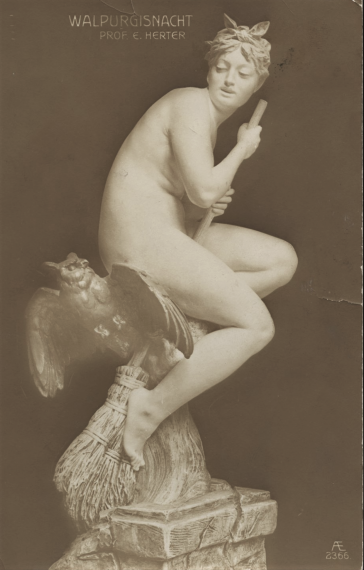
Ernst Gustav Herter, "Walpurgis".
The third part of her lyrical biography was titled “A Night for Witches” (Raganu nakts, 1923). The witch symbolises irrational and Dionysian strength, but she is also the source of the life and youth that both strengthened and tore up the author of the collection.
Egypt
Reproduction of Friedrich Perlberg's artwork.
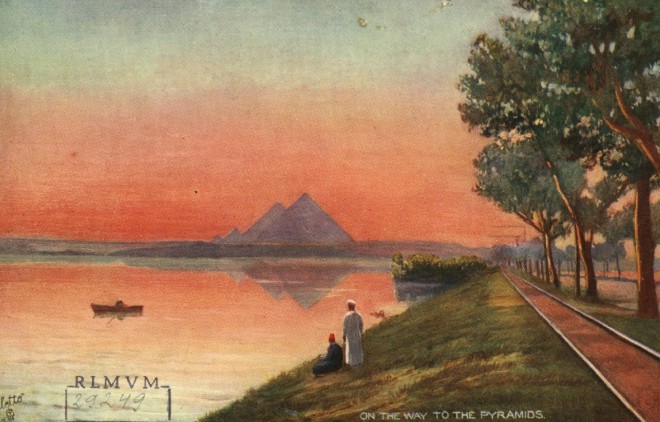
Reproduction of an unknown artist's "On the Way to the Pyramids"
Aspazija and Rainis often sent postcards to one another. Aspazija most often chose ones with images of Egypt, particularly those produced by the German architects and painters Friedrich Perlberg and Carl Wuttke. It is clear that Aspazija purchased whole sets of postcards. Both painters specialised in landscape painting, and many of their paintings were reproduced on postcards.

Reproduction of Friedrich Perlberg's "Sand Storm Near the Great Sphynx"
During the 19th century, there was a flourishing of historical research, archaeology and ethnography. Interest in these sectors was fired up by the fact that Napoleon’s armies found the Rosetta Stone, which made it possible to decode ancient Egyptian texts. During the early part of the 20th century, archaeologists found much evidence under the Egyptian sands that had been hidden for millennia. For the first time, the civilisation of Ancient Egypt was seen as a suggestive secret.
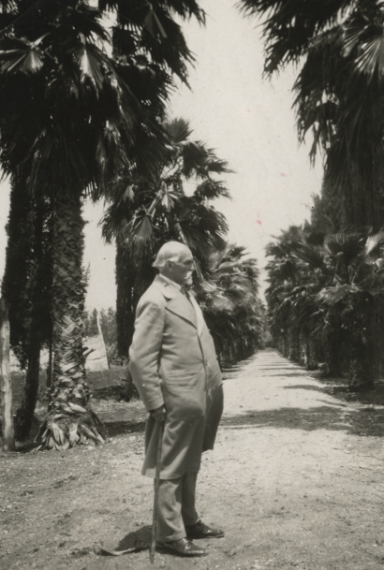
Rainis in Palestine, 1929. Unknown photographer
Rainis and Aspazija were interested in ancient history. In her memoir, Aspazija wrote that Rainis dreamed about his play “Joseph and His Brothers” (Jāzeps un viņa brāļi) shortly before the 1905 Revolution and then spent 14 years in writing the play. Rainis’ last foreign trip was one that he had long dreamed of ˗ a trip to Palestine and Egypt.
Poppies
Reproduction of Ludwik Stasiak's "Girl in Field of Poppies"
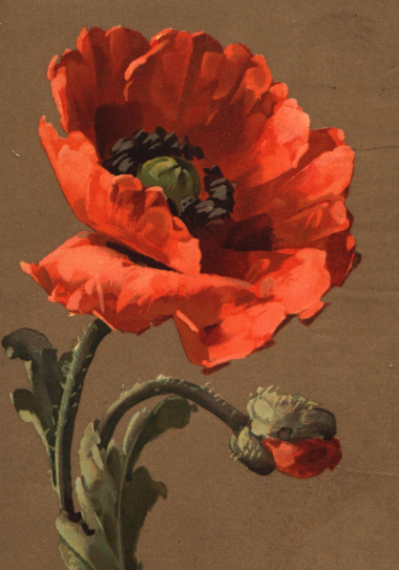
Postcard by Catharina Klein.
Along with narcissus, blooming cactuses, roses and edelweiss illustrations, Aspazija’s collection also contains several images of rosy poppies. Three of the designs were painted by German postcard designer Catharina Klein. She specialised in the painting of flowers, and one of her most unusual works was an alphabet of flowers.
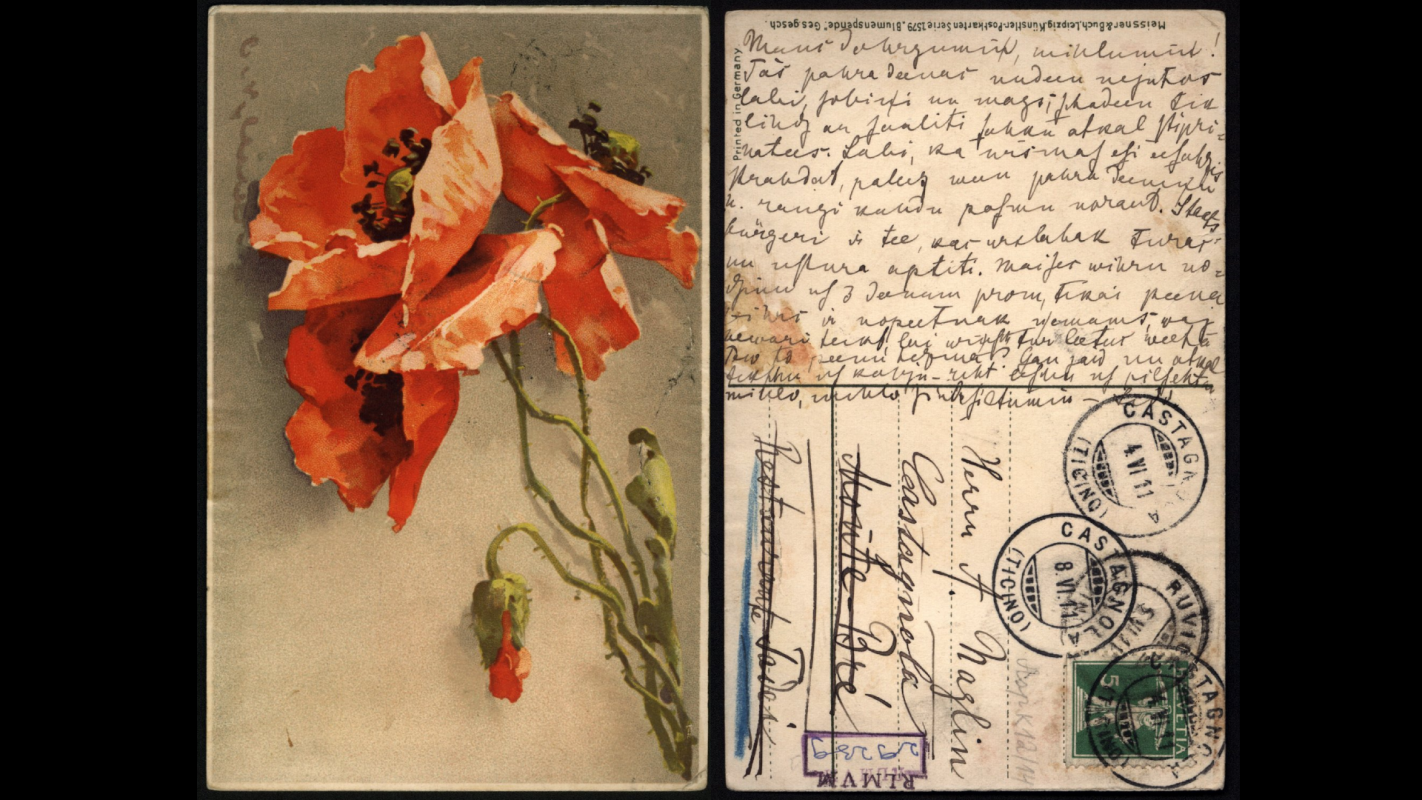
Postcard sent by Aspazija to Rainis on June 4, 1911. Postcard by Catharina Klein.
Mans dārgumiņ, mīļumiņ! Tās pāra dienas nudien nejūtos labi, zobiņi un māgs; šodien tik līdz ar saulīti sāku atkal stiprināties. Labi, ka vismaz esi iesācis strādāt, paliec vien pāra dieniņu un raugi kādu posmu noraut. Staatsbürgeri ir tie, kas vislabāk turas un uztura ap[e]tīti. Maizes vīru nodzinu uz 3 dienām prom, tikai piena vīrs ir nopietnāk ņemams, vai nevari teikt, lai viņš tur lietus vietā Tev to pienu tecina? Gan jau nu atkal tikšu uz kāju – rīt iešu uz pilsētu, mīļo, mīļo sirdssiltumiņ. – Lido.
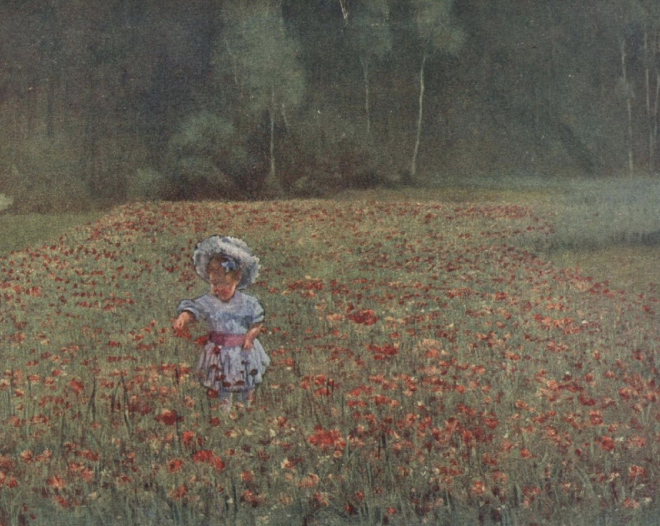
Reproduction of Carl Schuster's "Carefree Princess".
The poppy also appears in Aspazija’s poems. The second part of her lyrical biography, “Armful of Flowers” (Ziedu klēpis, 1911) is concluded with a chapter that is titled “Poppies.”
In “Armful of Flowers” the yearnings of the young woman lead her away from all that is old and traditional. Aspazija’s spirit rebelled against current events, and she went into the wide world to see her true challenge.
Frontispiece of Aspazija's "Armful of Flowers" (Ziedu klēpis, Rīga: Dzirciemnieki, 1911)

Postcard by Catharina Klein.
The poet’s attitude toward poppies was ambivalent, however. Aspazija was offended when writer Zenta Mauriņa presented her with a bouquet of poppies. Aspazija thought that this meant that Mauriņa saw her as a less than serious woman.

